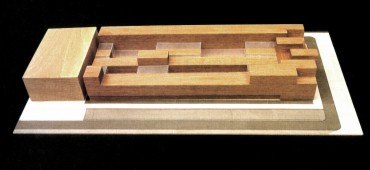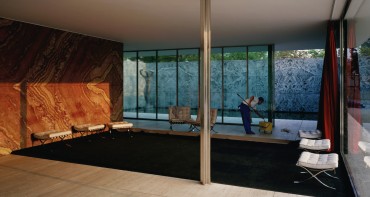
Mateo Arquitectura, Borneo Housing, Amsterdam

Jeff Wall, Morning Cleaning, Mies van der Rohe Foundation, Barcelona, 1999
16.7.2014 – Issue 17 - Pedagogy – Mateo Josep Lluís – Studio
Models and Images
by Josep Lluis Mateo
Models and images are tools or instruments that provoke the transport or passage of abstract ideas to physical reality.
MODELS
1 Volume
All buildings have a volume, some kind of shape or sculptural presence with a certain definition of the relations between voids and mass. In many cases the definition of the volume is a key question; it helps at the outset to define the size / proportion / form of the object in relation to the context. These volumetric studies make it possible to recognize hierarchies or connections between its parts and the surroundings, and help control the compositional tensions of the whole figure and urban gesture. They are usually quite small, more massiv, out of wood, for instance. Unanswered remain commonly questions of surface and tectonic articulation, for which bigger-scale models and mock-ups are required.
2 Space
Producing space always means introducing voids into the mass, the volume. In many occasions, space as a void defined by certain limits is difficult to understand and develop with only the plans. In order to notice all the components of the space - light, materiality, scale, movements - such spatial models are usually of bigger scale to allow for this sort of introspection, sometimes reaching even the scale of 1:1 to clarify certain guiding lines. They can be built in various ways: there exist additive and subtractive techniques, or the possibility to cast the negative frame out of the positive mold.
3 Structure
For one thing, the structure introduces order to the more homogeneous mass of the volume. Not necessarily hidden, it might also be brought to expression as a space-defining element. Some structural models might be useful in order to verify the static calculations of a construction in a more empirical and less mathematical way. In this sense, the force of gravity might even work as a formative agent defining both space and volume in the most optimized way.
4 Communication
Not connected to the development of a project, but fundamental to our profession, this models help to explain our ideas to people not necessarily involved with architecture. Easier to understand than the more abstract plans, they are an important instrument of explanation.
IMAGES
Again an important tool of communication, but more difficult to classify, the image defines a scene with people and objects, hence, it is closely connected to pictorial art, photography or film by targeting issues of surrealism, ground and figure, the limits of the set frame, or the presence of light and shadow. The way of producing such images has dramatically changed since the introduction of the computer: 10 years ago images started to be done in Photoshop in order to produce in a rather primitive fashion pop-art like collages, while today the fiction of the images appears almost more real and powerful than then the actual architecture. Altough they have a great seductive power, one has to remember that these images are superficial: like paintings they are two-dimensional, flat sheets to be looked at, but not to be immersed in like a model; they show the surface of things but not the three-dimensional, more synthetic qualities and dimensions of a space. They are fictions told from one precise and chosen point of view, but often difficult to transform into a real tectonic building with many angles to be studied and developed. A more current tendency is the production of films, which clearly transcends certain of the images‘ drawbacks and offers another way to easily (however, not technically) present a project. There the static and frozen character of the image is transformed into something more dynamic.
Download article as PDF

